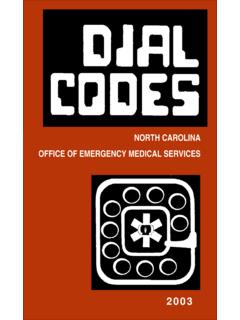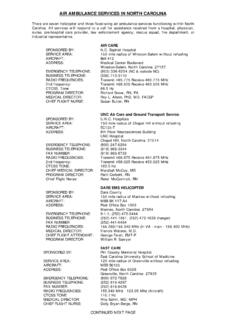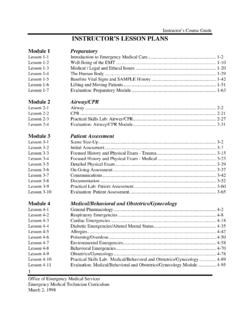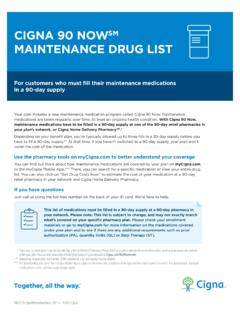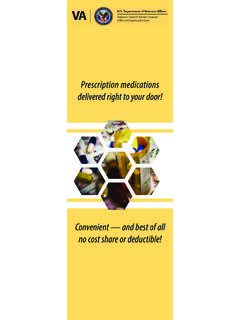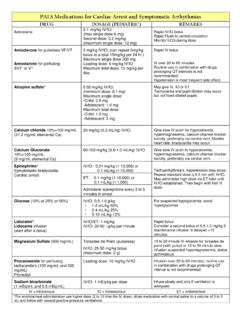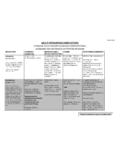Transcription of NORTH CAROLINA EMS MEDICATION FORMULARY
1 NORTH CAROLINA Medical board approved Medications for credentialed EMS personnel EMS personnel at any level who administer medications must do so within an EMS system that provides medical oversight. personnel must follow written treatment protocols and must complete appropriate medical education. All EMS System protocols and policies must be reviewed and approved by the Medical Director of the Office of EMS. All items highlighted in red are required by NCCEP in all systems with EMS personnel credentialed at the specified level. Specialty Care (SCTP) required items are not listed here, as they can be found on the Specialized Ambulance Protocol Summary (SAPS) form. Medications EMR EMT AEMT MEDIC. ACE inhibitors X. Acetaminophen X X X15 X. Adenosine X. Aminophylline X. Amiodarone X. Anti-arrhythmic X12. Antibiotics X. Anti-emetic preparations X. Antivirals X. Aspirin X X X. Atropine X4 X4 X4 X. Barbiturates X. Benzodiazepine preparations X14. Beta agonist preparations X2 X X.
2 Beta blockers X13. Bretylium X. C1 Esterase-Inhibitors X. Calcium channel blockers X13. Calcium chloride/gluconate X. Charcoal X X X. Clonidine X. Clopidogrel X. CroFab (Crotalidae Polyvalent Immune Fab) X8. Crystalloid solutions X X. Cyanide poisoning antidote kit X. Digoxin X. Diphenhydramine X3 X3 X X. Dobutamine X. Dopamine X. Droperidol X. Epinephrine X1 X1 X X. Etomidate X. Flumazenil X. Furosemide X. Glucagon X X. Glucose, oral X X X X. Glucose solutions X X. Haloperidol X. Heparin (unfractionated and low molecular weight) X. Last revision: June 15, 2018 1. Medications EMR EMT AEMT MEDIC. Histamine 2 blockers X X. Hydroxocobalamin X. Immunizations X6 X6. Insulin X. Ipratropium X X. Isoproterenol X. Ketamine X7. Levetiracetam X. Lidocaine X. Magnesium sulfate X. Mannitol X. Methylene blue X. Milrinone X. N-acetylcysteine X. Narcotic analgesics X. Narcotic antagonists X9,10 X9,10 X X. Nasal spray decongestant X X X. Nesiritide X. Nitroglycerin X2 X X.
3 Nitroprusside sodium X. Nitrous oxide X. Non-prescription medications X X X. Non-steroidal anti-inflammatory X X15 X. Norepinephrine X. Octreotide X. Oxygen X5 X5 X5 X5. Oxytocin X. Paralytic agents X7. Phenothiazine preparations X. Phenylephrine X. Phenytoin preparations X. Plasma protein fraction X. Platelet g-II/IIIa inhibitors X. Potassium chloride X. Pralidoxime X4 X4 X4 X. Procainamide X. Procaine X. Proparacaine X. Propofol X8. Proton pump inhibitors X. Sodium bicarbonate X. Steroid preparations X. Thiamine X X. Thrombolytic agents X. Topical hemostatic agents X X X X. Total Parenteral Nutrition X. Tranexamic Acid (TXA) X11. Tuberculosis skin test X6 X6. Valprocic acid X. Vasopressin X X. Vasopressor X16. Last revision: June 15, 2018 2. Medications EMR EMT AEMT MEDIC. Whole blood and components X. Ziprasidone X. 1 EMR and EMT use of epinephrine is limited to the treatment anaphylaxis and may be administered only by auto injector, unless approved by EMS System Medical Director and OEMS.
4 2 EMT use of beta-agonists and nitroglycerine is limited to patients who currently are prescribed the MEDICATION . EMTs may administer these medications from EMS supplies. EMT use of beta-agonists may be through any inhaled method of MEDICATION administration. 3 EMR/EMT administration of diphenhydramine is limited to the oral route. 4 As a component of preparedness for domestic terrorism, EMS personnel , public safety officers, and other first responders recognized by the EMS system, may carry, self-administer, or administer to a patient atropine and/or pralidoxime, based on written protocols and medical direction. All personnel except for Paramedics must administer these medications by an auto injector. 5 Administration of oxygen does not require medical direction. 6 Administration of immunizations and TB skin tests are not limited to public health initiatives. 7 Can only be used as induction agent for RSI or for post intubation sedation. 8 Can only be used for interfacility transport where infusion has already been started at transferring facility.
5 EMS units cannot carry Propofol or CroFab. This MEDICATION must be provided by the transferring hospital. 9 FR, EMR, and EMT administration of Naloxone is limited to the intra-nasal (IN), intra-muscular (IM), and auto-injector routes. 10. First Responder agencies are allowed to administer Naloxone with the following requirements: a. They must administer the Naloxone under the medical oversight of the County EMS Medical Director, and be incorporated into the respective EMS System in which they are administering the Naloxone. b. They must receive appropriate training and continuing education as approved by the County EMS Medical Director. c. The Naloxone must be administered as part of a protocol and procedure approved by the County EMS Medical Director, and the NC Office of EMS. d. All administration of Naloxone must be reviewed by the EMS Peer Review/Quality Management Committee of the EMS. System, which functions under the supervision of the local County EMS Medical Director.
6 11 For an EMS System to use Tranexamic Acid (TXA), they must submit for approval by the OEMS State Medical Director a signed letter from any Trauma Centers that would be the recipient of the patient that the destination Trauma Center agrees with its use and will give the 2nd required dose of Tranexamic Acid (TXA). 12 All Paramedic systems must carry some form of anti-arrhythmic agent. This must either be amiodarone, lidocaine, or procainamide. 13 Paramedic systems must carry either a calcium channel blocker or beta-blocker. 14 All Paramedic systems must carry some form of injectable benzodiazepine. 15 EMT-Intermediate/AEMT systems must carry either acetaminophen or a non-steroidal anti-inflammatory. 16 All Paramedic systems must carry an approved vasopressor. This must either be dobutamine, dopamine, epinephrine, norepinephrine, phenylephrine, or vasopressin. Last revision: June 15, 2018 3. NORTH CAROLINA Medical board approved Skills for credentialed EMS personnel EMS personnel performing these skills must do so within an EMS system.
7 personnel must follow written treatment protocols and must complete appropriate medical education. All EMS System protocols and policies must be reviewed and approved by the Medical Director of the Office of EMS. All items highlighted in red are required by NCCEP in all systems with EMS personnel credentialed at the specified level. Specialty Care (SCTP) required items are not listed here, as they can be found on the Specialized Ambulance Protocol Summary (SAPS) form. Skills EMR EMT AEMT MEDIC. 12-Lead ECG Acquisition & Transmission X X X. 12-Lead ECG Interpretation X. 15-Lead ECG Acquisition X. Arterial Access - Blood Draw X. Arterial Line maintenance X. Blind Insertion Airway Device (BIAD) X1 X X. Capnography (Waveform) X6 X6 X6. Carbon Monoxide Measurement (non-invasive) X X X X. Cardiac Monitoring X4 X4 X. Cardiac Pacing X. Cardiopulmonary Resuscitation X X X X. Cardioversion X. Carotid Massage X. Central Venous Pressure Line Maintenance X. Chest Compression-External Device X X X.
8 Chest Decompression-Needle X. Chest Tube Maintenance X. Childbirth X X X X. Cricothyrotomy-Needle X. Cricothyrotomy-Surgical X5. Decontamination X X X X. Defibrillation-Automated X X X X. Defibrillation-Manual X. Direct Laryngoscopy X X. Endotracheal Tube Introducer X X. Epidural Catheter Maintenance X. Foreign Body Airway Obstruction X X X X. Gastric Intubation X3 X3 X. Glucose Measurement X X X X. Hemostatic Agent X X X X. Injections Subcutaneous and Intramuscular X2 X X. Intra-Ventricular Catheter Maintenance X. Intubation - Nasotracheal X X. Intubation - Orotracheal X6 X6,7. Intubation Confirmation - Capnometry (color) X X. Intubation Confirmation - Esophageal Bulb X X. MEDICATION Administration X2 X2 X2 X2. Nebulizer Inhalation Therapy X X X. Last revision: June 15, 2018 4. Skills EMR EMT AEMT MEDIC. Non-Invasive Positive Pressure Ventilation X X X. Orthostatic Blood Pressure X X X X. Oxygen Administration X X X X. Patient Assessment X X X X. Pulse Oximetry X X X X.
9 Rapid Sequence Induction (RSI) X5,6. Reperfusion Checklist X X X X. Respirator Operation X X X. Restraints X X X. Spinal Motion Restriction X X X X. Splinting X X X X. Stroke Screen X X X X. Suction X X X X. Swan-Ganz Catheter maintenance X. Taser Probe Removal X X X X. Temperature Measurement X X X X. Tourniquet Application X X X X. Tracheostomy Tube Change X X. Urinary Catheterization X. Venous Access-Blood Draw X X. Venous Access-Existing catheters X. Venous Access-Femoral Line X. Venous Access-Intraosseous X X. Venous Access-Peripheral X X. Ventilator Operation X8 X8 X. Wound Care X X X X. 1. EMTs using blind insertion airway devices must be functioning in EMS systems with medical direction and written treatment protocols. 2. EMS personnel at any level who administer medications must do so within an EMS system that provides medical oversight. personnel must follow written treatment protocols and must complete appropriate medical education. All EMS System protocols and policies must be reviewed and approved by the Medical Director of the Office of EMS.
10 The approved MEDICATION list is found at the beginning of this document. The administration of oxygen does not require medical direction. 3. Gastric tube insertion may be performed only when utilized in conjunction with a blind insertion airway device. 4. EMT and AEMT may use the cardiac monitor for vital sign monitoring and EKG transmission. 5. Systems performing rapid sequence induction must have the ability to perform surgical cricothyrotomy. Commercial cricothyrotomy or tracheostomy kits that create an airway comparable to a surgical cricothyrotomy are acceptable. 6. Capnometry or capnography is mandatory with all methods of intubation. Continuous capnography (EtCO2) is strongly recommended for the monitoring of all patients with a BIAD and mandatory with monitoring of an endotracheal tube. 7. Pediatric intubation is an optional skill/procedure. 8. Ventilator patients may be transported by EMT/AEMT when all of the following conditions are met: -Patient is receiving home (or skilled nursing) ventilator therapy.

